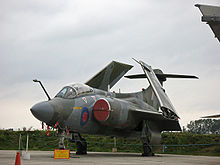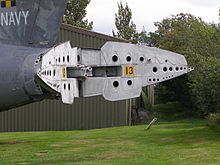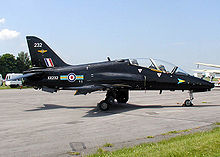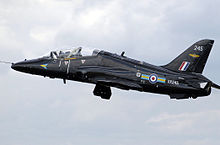- No. 208 Squadron RAF
-
No. 208 Squadron RAF Active 26 October 1916 – 7 November 1919
1 February 1920 - 30 March 1959
1 April 1959 - 10 September 1971
1 March 1974 - 31 March 1994
1 April 1994 - presentCountry  United Kingdom
United KingdomBranch  Royal Air Force
Royal Air ForceRole Advanced flying training
Instructor training
Conversion trainingBase RAF Valley Motto Vigilant[1] Aircraft BAe Hawk Battle honours Western Front 1915-1918*
Arras*
Ypres 1917*
Lys
Somme 1918*
Egypt and Libya 1940-1942*
Greece 1941*
Iraq 1941
Syria 1941
El Alamein*
Italy 1944-1945*
Gustav Line
Gothic Line
Gulf 1991*
Honours marked with an asterisk* are those emblazoned on the Squadron StandardCommanders Notable
commandersGeoffrey Rhodes Bromet Insignia Squadron Badge heraldry A sphinx affrontée[1][2]
The Gizah Sphinx commemorated the Squadron's long association with Egypt during the inter-war years. An unofficial 'winged eye' badge had been in use from July 1930 until 1937.[3]Squadron Codes GA (Apr 1939 - Sep 1939)[4][5]
RG (Mar 1944 - 1949)[6][7]
S (Carried on Buccaneers)[8]
D (1994 - present)[9]No 208 (Reserve) Squadron is at present a reserve unit of the Royal Air Force based at RAF Valley, Anglesey, Wales. It operates the BAe Hawk aircraft.
Contents
History
World War I
The squadron was established as part of the Royal Naval Air Service on 25 October 1916[10][11] at Dunkirk as No. 8 (Naval) Squadron. In its earlier days, the unit flew Sopwith Pups, 1½ Strutters and Nieuport Scouts. Later in World War I it re-equipped with Sopwith Camels and was assigned to artillery spotting. The squadron returned to the UK briefly before being sent back to France to face the German offensive. While in France a significant number of Camels belonging to the squadron were destroyed by the RAF to prevent the Germans capturing them during their advance. When the Royal Air Force was formed on 1 April 1918, the unit was renumbered to No. 208 Squadron RAF. After the war ended 208 Squadron remained with the occupying forces until August 1919, when it again returned to the UK for disbandment on 7 November 1919 at Netheravon.[12]
During the war, the squadron claimed 298 victories. Twenty-five aces had served in the squadron. Notable among them were Anthony Arnold, Charles Dawson Booker, Robert J. O. Compston, Harold Day, Stanley Goble, Edward Grahame Johnstone, William Lancelot Jordan, Robert A. Little, William E. G. Mann, Richard Munday, Guy William Price, George Simpson, Reginald Soar, Ronald Thornley, and James White.[13]
Interbellum
The squadron reformed at RAF Ismailia in Egypt on 1 February 1920 by the renumbering of No. 113 Squadron RAF.[14] It was at first equipped with RE8s and from November 1920 till May 1930 with Bristol Fighters. The years between the wars were by no means quiet, in September 1922 the squadron was sent to Turkey for a year during the Chanak crisis, being stationed at San Stefano, a part of the Bakırköy district of Istanbul, Turkey.[14] After the conflict 208 Squadron went back to Egypt and in 1930 got Armstrong Whitworth Atlas aircraft to replace the old Bristol fighters. The Atlases in their turn were replaced five years later by Audaxes and for one flight by Demons. Just before the outbreak of World War II, in January 1939, these gave way for the Westland Lysander.[15]
World War II
No.208 Squadron was still stationed in Egypt at the outbreak of World War II. It joined the war effort in mid-1940 flying Westland Lysander reconnaissance aircraft and Hawker Hurricane fighters on army co-operation duties in the North African Campaign and the Greek Campaign of 1941. During the war it included a significant number of Royal Australian Air Force and South African Air Force personnel, along with other nationalities. Amongst the members of the squadron at this time was Robert Leith-Macgregor, shot down on more than one occasion, once ending up taxiing through a minefield, but managed not to trigger any mines.[16]
The unit was later stationed in Palestine, before returning to North Africa. It briefly converted to Curtiss Tomahawks, but received Supermarine Spitfires in late 1943 and flew them for the remainder of the war. From 1944, it took part in the Italian Campaign.
After World War II
Shortly after the war 208 Squadron moved back to Palestine where it was involved in operations against the Egyptian Air Force. In 1948, the squadron moved to the Egyptian Canal Zone. It saw action in the Israeli War of Independence, losing four Spitfires in combat with Israeli Air Force aircraft (which also included Spitfires).
The last officially recorded "Air to Air fighter pilot kill" (bullets only without guidance systems) occurred on 22 May 1948, at 09:30 two Egyptian Spitfire LF.9s decided to stage a third attack on Ramat David. This time Fg Off Tim McElhaw and Fg Off Hully of 208 Squadron had taken over the standing patrol. Fg Off McElhaw, flying Spitfire FR.18 TZ228, managed to intercept and shoot down both LF.9s.[17]
In 1951, the squadron relocated to RAF Fayid where its Spitfires were replaced with Gloster Meteor jets. From there it moved to RAF Abu Sueir, relocating to RAF Takali, Malta, in August 1956, with interim spells earlier in the year at RAF Hal Far, Malta, and RAF Akrotiri, Cyprus. It disbanded at Takhali in January 1958, but it reformed the same month in the UK at RAF Tangmere from a nucleus of No. 34 Squadron RAF.[18] Two months later it returned to the Middle East with de Havilland Vampires and subsequently Hawker Hunter FGA.9s. In 1958 and early 1959 it operated from RAF Nicosia and RAF Akrotiri with a detachment at Amman, Jordan. The squadron disbanded at RAF Akrotiri on 31 March 1959.
The next day, 1 April 1959, it reformed at RAF Eastleigh, Nairobi, Kenya, by the re-numbering of No. 142 Squadron RAF under Squadron Leader R. Ramirez.[19] It operated from Eastleigh from April 1959 to March 1960, being redeployed home to RAF Stradishall from March to June 1960, but returning to Eastleigh in June, sending detachments to Kuwait and Bahrain during the period. It was moved to RAF Khormaksar in Aden in November 1961, under Air Forces Arabian Peninsula, which became Air Forces Middle East the same year.[20] In June 1964 it moved to Muharraq in Bahrain.The squadron remained in the Middle East until September 1971 when it was disbanded as a consequence of British drawdown of the armed forces from East of Suez.
Flying Buccaneers
 RAF Buccaneer S.2 with wings folded
RAF Buccaneer S.2 with wings folded
208 Squadron reformed at RAF Honington in 1974 with Blackburn Buccaneer S2s, assigned to SACEUR operating in a low-level strike role. The squadron's twelve Buccaneers were declared operational to SACEUR from 1975 armed with twentyfour WE.177 nuclear weapons.[21] The squadron was tasked with supporting land forces resisting an advance by the Warsaw Pact into western Europe, by striking at enemy forces, logistics and infrastructure beyond the forward edge of the battlefield, initially with conventional munitions, and with nuclear weapons in the event of escalation.[22] The allocation of the British-owned WE.177 weapon freed the squadron from the time-consuming burden, at a critical time, of using US-owned nuclear weapons held in US custody at a central location. The squadron continued in this role based at RAF Honington until late 1983,[23] when it moved base to RAF Lossiemouth and was re-assigned to SACLANT for maritime strike duties. The squadron's allocation of WE.177 nuclear weapons was reduced to twelve, one per aircraft,[24] although the Buccaneer was able to carry two in its internal bomb bay.[25] The squadron continued in this role until late 1993[26] when it relinquished its nuclear weapons. The unit was one of the last squadrons to operate the Buccaneer before it went out of service in 1994, and after the type's retirement the squadron again disbanded on 31 March 1994.[12]
Present role
208 Squadron reformed again on 1 April 1994 from 234 (Reserve) Squadron, attached to No. 4 Flying Training School. It moved to RAF Valley operating the BAe Hawk that it continues to fly to this day. No.4 FTS is made up of two squadrons; 208 Squadron provides the advanced flying training, students then moving onto 19 Squadron to receive tactics and weapons training. The vast majority of sorties undertaken by 208 Squadron are flown to teach RAF ab-initio pilots the fundamental skills of flying a fast-jet, to prepare them for tactical weapons training and onwards towards front-line aircraft such as the Tornado, Harrier and Typhoon. A summary of 208 Squadron's present tasks:
Advanced flying training
- To train RAF, RN and some foreign ab-initio pilots as per the Personnel Training Command (HQPTC) Training Task Programme to Tactical Weapons Unit (TWU) entry standard.
- To re-train RAF and RN multi-engine and rotary pilots as per the HQPTC training Task Programme to TWU entry standard.
- To refresh Short Tucano QFIs as per the HQPTC Training Task Programme to TWU entry standard.
Instructor training
- To train Hawk QFIs as per the HQPTC Training Task Programme to B2 standard in accordance with the current Central Flying School (CFS) syllabuses.
- To upgrade Hawk QFIs to B1, A2 and A1 standard in accordance with the 208 Squadron staff training requirements and CFS syllabuses.
- To train Hawk IREs in accordance with the current CFS syllabuses.
- To convert Qualified Flying Instructors (Tactical Sequences) and Qualified Pilot Navigation Instructors into Hawk QFIs as per the Headquarters HQPTC training Task Programme to B2 standard in accordance with the current CFS syllabuses.
Conversion training
- To provide a common conversion course for all qualified pilots re-roling to the Hawk.
- To provide United Kingdom Orientation training for Foreign and Commonwealth pilots destined for fast-jet appointments.
- To provide conversion training for pilots destined for the Royal Air Force Aerobatics Team.
On 20 April 2007, a BaE Hawk from the squadron crashed near RAF Mona. The pilot was taken to hospital and discharged soon after. The accident was caused by a solo student stalling the aircraft on an overshoot.[27]
Aircraft operated
Aircraft operated by No. 8 Squadron RNAS and no. 208 Squadron RAF, data from[12][15][28] From To Aircraft Version October 1916 November 1916 Sopwith 1½ Strutter October 1916 December 1916 Nieuport Scout October 1916 February 1917 Sopwith Pup February 1917 September 1917 Sopwith Triplane September 1917 November 1918 Sopwith Camel November 1918 September 1919 Sopwith Snipe February 1920 November 1920 Royal Aircraft Factory R.E.8 November 1920 May 1930 Bristol F.2 Fighter F.2b May 1930 August 1935 Armstrong Whitworth Atlas August 1935 January 1939 Hawker Audax September 1935 March 1936 Hawker Demon January 1939 May 1942 Westland Lysander Mks.I, II November 1940 September 1942 Hawker Hurricane Mk.I May 1941 June 1941 Hawker Audax May 1942 September 1942 Curtiss Tomahawk Mk.IIb May 1942 December 1943 Hawker Hurricane Mks.IIa, IIb, IIc December 1943 July 1944 Supermarine Spitfire Mk.Vc March 1944 June 1947 Supermarine Spitfire Mk.IX August 1944 October 1944 Supermarine Spitfire Mk.VIII August 1946 March 1957 Supermarine Spitfire FR.18 March 1951 January 1958 Gloster Meteor FR.9 January 1958 February 1958 Hawker Hunter F.5 January 1958 March 1959 Hawker Hunter F.6 April 1959 March 1960 de Havilland Venom FB.4 March 1960 September 1971 Hawker Hunter FGA.9 October 1974 March 1994 Blackburn Buccaneer S.2A, S.2B April 1994 Present BAe Hawk T.1, T1A References
- Notes
- ^ a b Halley 1988, p. 270.
- ^ "Badge - "A sphinx affrontee proper"". www.rafvalley.org. No. 208 Squadron RAF. http://www.rafvalley.org/208sqn/Badges/crest/crest.html. Retrieved 31 March 2011.
- ^ "The Flying Shuftis". www.rafvalley.org. No. 208 Squadron RAF. http://www.rafvalley.org/208sqn/Badges/shufti/shufti.html. Retrieved 31 March 2011.
- ^ Bowyer and Rawlings 1979, p. 14.
- ^ Flintham and Thomas 2003, p. 50.
- ^ Bowyer and Rawlings 1979, p. 89.
- ^ Flintham and Thomas 2003, p. 104.
- ^ Flintham and Thomas 2003, p. 198.
- ^ Flintham and Thomas 2003, p. 199.
- ^ Marr 1966, pp. 1, 105, 109.
- ^ Johnstone 1972, pp. 10, 183, 189.
- ^ a b c Jefford 2001, p. 72.
- ^ "8 Naval". www.theaerodrome.com. The Aerodrome. http://www.theaerodrome.com/services/gbritain/raf/208.php. Retrieved 6 March 2010.
- ^ a b Marr 1966, p. 13.
- ^ a b Marr 1966, p. 111.
- ^ "Obituaries: Lieutenant-Colonel Robert Leith-Macgregor, Pilot who won an MC and was pulled from his burning cockpit by German troops after one of several crashes.". www.telegraph.co.uk (The Daily Telegraph). 7 January 2009. http://www.telegraph.co.uk/news/obituaries/4163054/Lieutenant-Colonel-Robert-Leith-Macgregor.html. Retrieved 18 January 2009.
- ^ Marr 1966, p. 79.
- ^ Marr 1966, p. 89.
- ^ Rawlings 1978, p. 323.
- ^ Rawlings 1984, p. 261.
- ^ Burnell, Brian. "RAF nuclear front line Order-of-Battle 1975". nuclear-weapons.info. http://nuclear-weapons.info/images/1975.PNG. Retrieved 31 March 2011.
- ^ Burnell, Brian (7 November 2010). "WE.177". http://www.nuclear-weapons.info/vw.htm#WE.177%20carriage. Retrieved 31 March 2011.
- ^ Burnell, Brian. "RAF nuclear front line Order-of-Battle 1983". nuclear-weapons.info. http://nuclear-weapons.info/images/1983.PNG. Retrieved 31 March 2011.
- ^ Burnell, Brian. "RAF nuclear front line Order-of-Battle 1984". nuclear-weapons.info. http://nuclear-weapons.info/images/1984.PNG. Retrieved 31 March 2011.
- ^ Rotating bomb door animation with WE.177
- ^ Burnell, Brian. "RAF nuclear front line Order-of-Battle 1993". nuclear-weapons.info. http://nuclear-weapons.info/images/1993.PNG. Retrieved 31 March 2011.
- ^ "RAF jet crash at island airfield". news.bbc.co.uk (BBC). 20 April 2007. http://news.bbc.co.uk/1/hi/wales/6575793.stm. Retrieved 31 March 2011.
- ^ Halley 1988, p. 271.
- Bibliography
- Johnstone, E.G., DSC (Editor). Naval Eight: A history of No.8 Squadron R.N.A.S. - afterwards No. 208 Squadron R.A.F - from its formation in 1916 until the Armistice in 1918. Naval and Military Press, 2006 (Reprint of the 1931, The Signal Press (London) Original Edition). ISBN 1-84342-986-1.
- Halley, James J. The Squadrons of the Royal Air Force & Commonwealth 1918-1988. Tonbridge, Kent, UK: Air Britain (Historians) Ltd., 1988. ISBN 0-85130-164-9.
- Jefford, C.G., Wing Commander MBE, BA, RAF (Retd). RAF Squadrons, a Comprehensive Record of the Movement and Equipment of all RAF Squadrons and their Antecedents since 1912. Shrewsbury, Shropshire, UK: Airlife Publishing Ltd., 1998 (second edition 2001). ISBN 1-84037-141-2.
- Johnstone, E.G. Naval Eight. The signal Press Ltd., 1931 (2nd edition Arms and Armour Press, 1972). ISBN 1-85368-469-3.
- Marr, D.S.B., BSc. A History of 208 Squadron. Southend-on-Sea, Essex, UK: RAF/Eden Fisher (Southend) Ltd., 1966.
- Moyes, Philip J.R. Bomber Squadrons of the RAF and their Aircraft. London: Macdonald and Jane's (Publishers) Ltd., 1964 (new edition 1976). ISBN 0-354-01027-1.
- Rawlings, John D.R. Fighter Squadrons of the RAF and their Aircraft. London: Macdonald & Jane's (Publishers) Ltd., 1969 (2nd edition 1976, republished 1978). ISBN 0-354-01028-X.
- Rawlings, John D.R. The History of the Royal Air Force. Feltham, Middlesex, UK: Temple Press/Aerospace, 1984. ISBN 0-60034-990-X.
- Styles, Dr. David G. 75 Years on - "The Flying Shuftis": Number 208 Squadron, Royal Air Force. Deerfield, Illinois: Dalton Watson, 1991. ISBN 1-85443-101-3.
- Styles, Dr. David G. All the eights: Eight decades of Naval Eight/208. Loughborough, White Owl Press, 1996. ISBN 1-85443-131-5.
External links
Currently active Inactive 1 · 4 · 10 · 13 · 20 · 21 · 23 · 25 · 26 · 34 · 35 · 36 · 37 · 38 · 40 · 42 · 43 · 44 · 46 · 48 · 49 · 50 · 52 · 53 · 55 · 58 · 59 · 61 · 62 · 63 · 64 · 65 · 66 · 67 · 68 · 69 · 70 · 71 · 73 · 74 · 75 · 76 · 77 · 79 · 80 · 81 · 82 · 83 · 85 · 86 · 87 · 88 · 89 · 90 · 91 · 92 · 93 · 94 · 95 · 96 · 97 · 98 · 102 · 103 · 104 · 105 · 106 · 107 · 108 · 109 · 110 · 111 · 112 · 113 · 114 · 115 · 116 · 117 · 118 · 119 · 120 · 121 · 122 · 123 · 124 · 125 · 126 · 127 · 128 · 129 · 130 · 131 · 132 · 133 · 134 · 135 · 136 · 137 · 138 · 139 · 140 · 141 · 142 · 143 · 144 · 145 · 146 · 147 · 148 · 149 · 150 · 151 · 152 · 153 · 154 · 155 · 156 · 157 · 158 · 159 · 160 · 161 · 162 · 163 · 164 · 165 · 166 · 167 · 168 · 169 · 170 · 171 · 172 · 173 · 174 · 175 · 176 · 177 · 178 · 179 · 180 · 181 · 182 · 183 · 184 · 185 · 186 · 187 · 188 · 189 · 190 · 191 · 192 · 193 · 194 · 195 · 196 · 197 · 198 · 199 · 200 · 201 · 204 · 205 · 209 · 210 · 211 · 212 · 213 · 214 · 215 · 217 · 218 · 219 · 220 · 221 · 222 · 223 · 224 · 225 · 226 · 227 · 228 · 229 · 231 · 232 · 233 · 234 · 235 · 236 · 237 · 238 · 239 · 240 · 241 · 242 · 243 · 244 · 245 · 246 · 247 · 248 · 249 · 250 · 251 · 252 · 253 · 254 · 255 · 256 · 257 · 258 · 259 · 260 · 261 · 262 · 263 · 264 · 265 · 266 · 267 · 268 · 269 · 270 · 271 · 272 · 273 · 274 · 275 · 276 · 277 · 278 · 279 · 280 · 281 · 282 · 283 · 284 · 285 · 286 · 287 · 288 · 289 · 290 · 291 · 292 · 293 · 294 · 295 · 296 · 297 · 298 · 299 · 353 · 354 · 355 · 356 · 357 · 358 · 360 · 361 · 510 · 511 · 512 · 513 · 514 · 515 · 516 · 517 · 518 · 519 · 520 · 521 · 524 · 525 · 526 · 527 · 528 · 529 · 530 · 531 · 532 · 533 · 534 · 535 · 536 · 537 · 538 · 539 · 540 · 541 · 542 · 543 · 544 · 547 · 548 · 549 · 550 · 567 · 569 · 570 · 571 · 575 · 576 · 577 · 578 · 582 · 586 · 587 · 595 · 597 · 598 · 618 · 619 · 620 · 621 · 622 · 623 · 624 · 625 · 626 · 627 · 628 · 629 · 630 · 631 · 635 · 639 · 640 · 644 · 650 · 651 · 652 · 653 · 654 · 655 · 656 · 657 · 658 · 659 · 660 · 661 · 662 · 663 · 664 · 665 · 666 · 667 · 668 · 669 · 670 · 671 · 672 · 673 · 679 · 680 · 681 · 682 · 683 · 684 · 691 · 692 · 695
Australian Flying Corps (AFC) units attached
to the RAF during the First World WarCommonwealth air force units attached to
the RAF during the Second World War.Squadrons formed from non-Commonwealth
personnel during the Second World WarArgentineBelgian349 · 350CzechoslovakDutchFrenchGreek335 · 336NorwegianYugoslavRoyal Auxiliary Air Force Special ReserveAuxiliary Air ForceFleet Air Arm of the RAF (1924–1939) Royal Air Force portal Formations and units Commands · Groups · Stations · Wings · Aircraft squadrons · Aircraft flights · Conversion units · Regiment squadrons

Branches and components RAF Regiment · RAF Chaplains Branch · RAF Intelligence · RAF Legal Branch · Princess Mary's RAF Nursing Service · RAF Police · Search and Rescue Force · Mountain Rescue Service
Reserve forces Associated civil organizations Air Training Corps · RAF Association · RAF Centre of Aviation Medicine
Equipment List of RAF aircraft · List of RAF missiles
Personnel Symbols and uniform History · Timeline · Future Categories:- Royal Air Force aircraft squadrons
- Royal Naval Air Service squadrons
- Military units and formations established in 1916
- Military units and formations of the Royal Air Force in World War I
- Military units and formations of the Royal Air Force in World War II
- 1916 establishments in the United Kingdom
Wikimedia Foundation. 2010.



